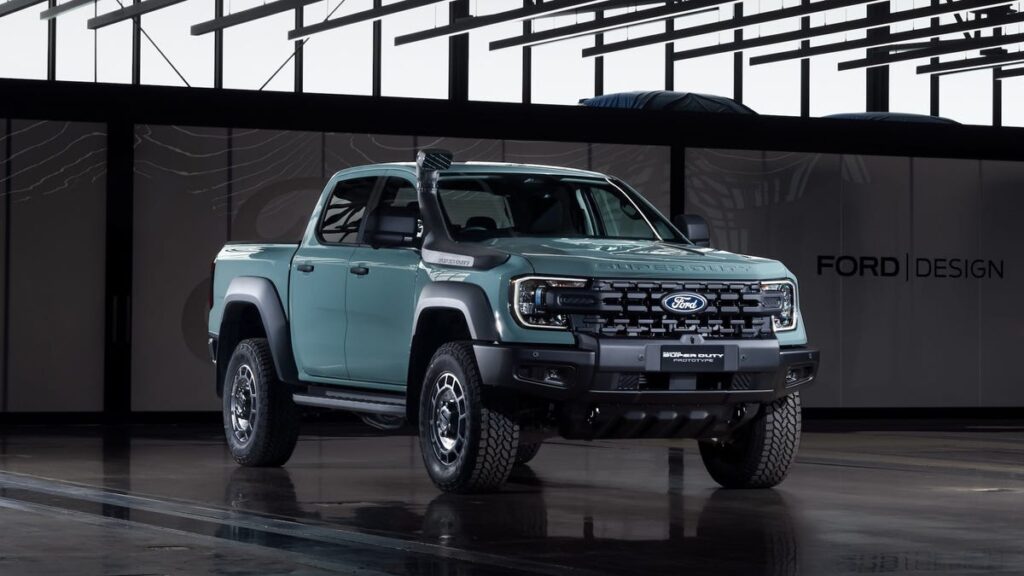The 2026 Ford Ranger, with its global platform, is used in a variety of markets — most of which are places where the larger F-150 that’s a staple in the U.S. isn’t available. The problem, at least for those foreign markets where the midsize Ranger represents the tippy top of Ford’s truck offerings, is that the Ranger isn’t built to work like a full-size F-150, while the F-150 isn’t sized to handle the tighter cities and roads where Rangers abroad spend their time. So it’s little wonder why Ford felt it was a good idea to build a heavy duty version of the Ranger, even though that sounds like — we know — a role logically filled by the existing F-150. Meet the 2025 Ford Ranger Super Duty, a workhorse midsize truck that will not be coming to America.
The call for a heavy-duty version of the Ford Ranger came from fleet managers looking for a truck they could use for the work they needed, including well off-grid in, say, Australia’s remote regions. This means the Ranger Super Duty isn’t just supposed to be another enthusiast model borrowing from the F-series, like the Ranger Raptor, but instead be a truly work-ready pickup truck at an appropriate size for global markets.
The changes are apparent from the moment you look at it. There is a set of 33-inch General Grabber tires that fit under unique fender flares that cover the new, girthier track width. They feature a squared-off design and are only available to the Super Duty. Moving towards the front, you’ll find that the bumper is a new, heavy-duty unit made from steel and features a skid plate, mounting points for driving lights, and increased tire clearance while still offering protection of the grille and headlights.
The Ranger Super Duty’s hood also features that logo embossed into its leading edge while the grille features a new open-weave mesh for improved airflow to the radiator. The snorkel is also standard equipment in case there comes a need to cross rivers and deep sections of water or dealing with the dust and dirt while working away from civilization. The mirrors are also taller and are functionally in line with the improved towing capacity as that would allow taller loads that would block the internal rearview mirror. The new GVM for the Ranger Super Duty is now around 9,920 pounds, going from the 6,790 pounds maximum of the regular Ranger.
Even with all this attention to detail, the Ranger Super Duty can still be upfitted to suit the individual needs of the owner, be it a farmer that needs to haul feed or a forestry service company needing trucks ready to head out into unpaved and rough terrain.
Inside, the Ranger Super Duty still features the amenities you’d find on the standard lineup, but more work focused. Even so, hopping inside you’re immediately greeted by an embossed “Super Duty” logo on the upper glovebox door. You’ll also find the standard 12-inch infotainment screen with auxiliary switches on the overhead console for those accessories you add to make your workday easier. Optionally, an Integrated Device Mounting system can be added that not only works with devices up to 8.82-pounds but also clears the passenger airbag zone, according to Ford.
Even as a work-oriented truck, the 2026 Ranger Super Duty still comes with ADAS features like front and rear parking aids, a 360-degree camera, blind spot monitoring with trailer coverage, forward collision warning, auto emergency braking and a lot more. The work truck should be less stressful and that appears to be the goal of the Ranger Super Duty by including these important safety features.
When’s it coming to the U.S.? Again, most likely never. The 2026 Ford Ranger Super Duty is going to markets where the Ford F-150 isn’t being offered or isn’t in realistic demand for work truck duty. The U.S. already has the entire F-series lineup, including heavy-duty work truck variants. Are the capabilities that the Ranger Super Duty have are well within what the F-150 is capable of? Of course, there is obvious overlap in most aspects save for size; and while bigger’s always better in America, that usually isn’t the case elsewhere.
Still, model overlap aside, we could see legitimate use cases for a truck smaller than the F-150 but with the same extra capability here in the U.S. But the American truck market isn’t big on nuance or clever niches — just ask Nissan about its Titan XD in-betweener, a full-size truck based on the half-ton Titan but uprated slightly to land somewhere, capability-wise, between the regular Titan and a full-on heavy-duty truck. Most truck buyers skipped right past that white-space offering, even if it made sense for most weekend warriors who towed or hauled a lot, and hopped into full-on heavy-duty, three-quarter-ton rigs. After all, why get only what you need when you can get what you want?
Photos by manufacturer
